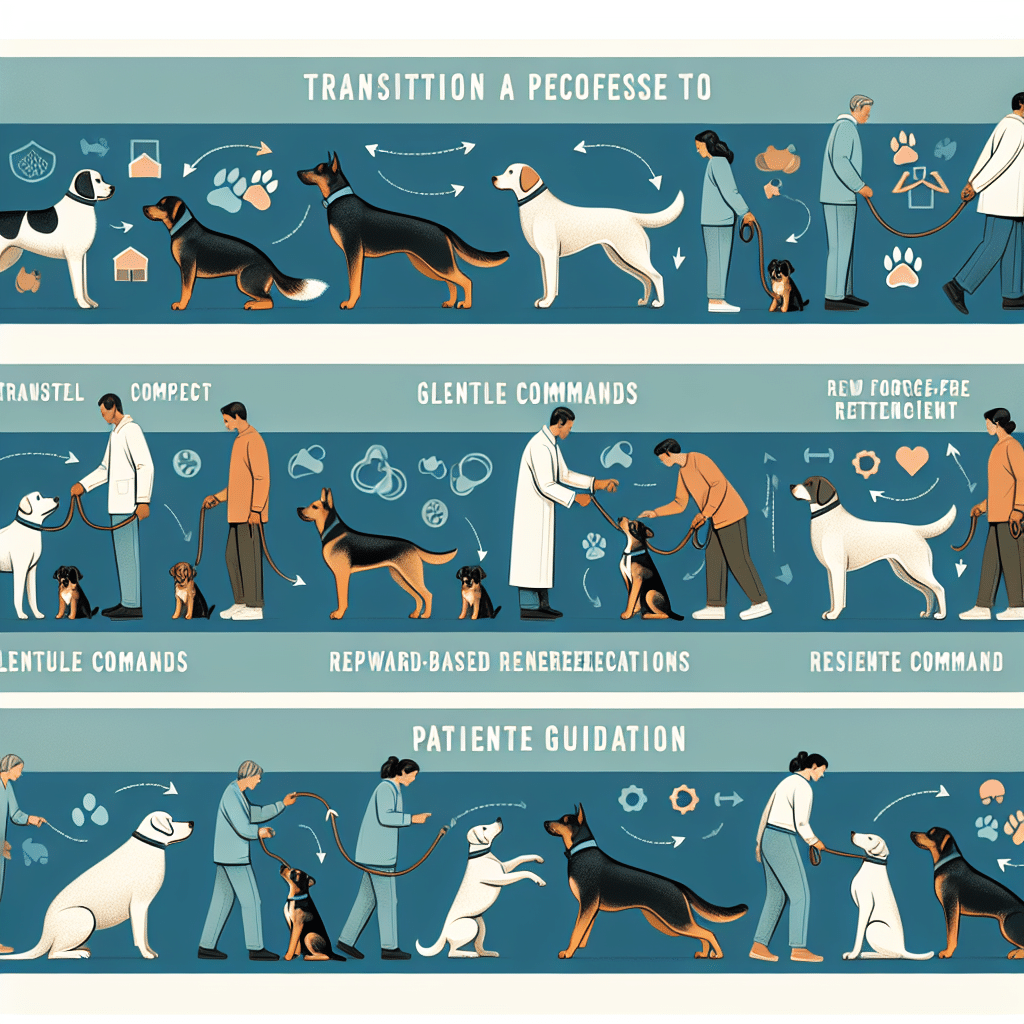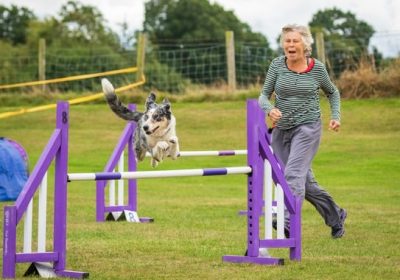How to Transition Your Dog to a Force-Free Training Approach
Table of Contents
Transitioning your dog to a force-free training approach involves shifting from traditional training methods, which may rely on punishment or aversive techniques, to a more positive, reward-based system. This approach emphasizes understanding and cooperation, focusing on reinforcing desirable behaviors through positive reinforcement, such as treats, praise, or play. By fostering a supportive and encouraging environment, force-free training not only enhances the bond between you and your dog but also promotes a more effective and humane way to address behavioral issues. This guide will explore the steps and strategies necessary to successfully implement force-free training, ensuring a smooth transition that benefits both you and your canine companion.
Understanding the Principles of Force-Free Dog Training
Force-free dog training is an approach that emphasizes positive reinforcement and the avoidance of punishment, aiming to foster a trusting and respectful relationship between the dog and its owner. Understanding the principles of this method is crucial for those looking to transition their dogs to a force-free training approach. At its core, force-free training is based on the idea that dogs learn best when they are motivated by rewards rather than fear of punishment. This method not only enhances the learning experience for the dog but also strengthens the bond between the pet and the owner.
To begin with, it is essential to recognize that force-free training relies heavily on positive reinforcement. This involves rewarding the dog for desired behaviors, which encourages the repetition of those behaviors. Rewards can take various forms, such as treats, praise, or playtime, and should be tailored to what the dog finds most motivating. By consistently rewarding good behavior, the dog learns to associate these actions with positive outcomes, making them more likely to repeat them in the future.
In addition to positive reinforcement, force-free training also involves the use of management techniques to prevent unwanted behaviors. This might include setting up the environment in a way that minimizes the chances of the dog engaging in undesirable actions. For instance, if a dog tends to chew on furniture, providing plenty of chew toys and ensuring that the dog is not left unsupervised in areas with tempting furniture can help manage this behavior. By preventing the dog from practicing unwanted behaviors, the owner can focus on reinforcing positive actions.
Another key principle of force-free training is the importance of understanding canine body language and communication. Dogs communicate primarily through body language, and being able to interpret these signals can greatly enhance the training process. By observing a dog’s body language, an owner can gain insights into the dog’s emotional state and adjust their training approach accordingly. For example, if a dog appears anxious or stressed, it may be beneficial to take a break from training or to modify the training environment to make it more comfortable for the dog.
Furthermore, patience and consistency are vital components of force-free training. Transitioning to this approach requires time and dedication, as dogs need to unlearn old habits and form new associations. Consistency in training methods and commands helps the dog understand what is expected of them, while patience ensures that the owner remains calm and supportive throughout the process. It is important to remember that each dog learns at its own pace, and progress may vary depending on the individual dog’s temperament and previous experiences.
In conclusion, transitioning to a force-free training approach involves understanding and applying several key principles, including positive reinforcement, management techniques, and effective communication. By focusing on these elements, dog owners can create a positive and supportive training environment that encourages learning and strengthens the bond between them and their pets. As more people recognize the benefits of force-free training, it is likely that this approach will continue to gain popularity, promoting a more humane and effective way of training dogs.
Step-by-Step Guide to Transitioning Your Dog to Force-Free Methods

Transitioning your dog to a force-free training approach is a rewarding journey that fosters a deeper bond between you and your canine companion. This method emphasizes positive reinforcement, patience, and understanding, steering away from punitive measures. To begin this transition, it is essential to first understand the principles of force-free training. This approach is rooted in the belief that dogs learn best when they are motivated by rewards rather than fear of punishment. By focusing on positive reinforcement, you encourage desirable behaviors through treats, praise, or play, making the learning process enjoyable for your dog.
The initial step in this transition involves assessing your current training methods. Reflect on the techniques you have been using and identify any that rely on aversive stimuli, such as yelling or physical corrections. Gradually phasing out these methods is crucial, as sudden changes can confuse your dog. Instead, start by incorporating positive reinforcement into your existing routine. For instance, if your dog sits on command, immediately reward them with a treat or verbal praise. This immediate feedback helps your dog associate the behavior with a positive outcome, reinforcing their willingness to repeat it.
As you integrate positive reinforcement, it is important to be consistent. Consistency is key in any training regimen, but it is especially vital when transitioning to a new approach. Ensure that all family members or anyone involved in your dog’s training are on the same page regarding the methods being used. This unified approach prevents mixed signals that could hinder your dog’s progress. Additionally, consistency in commands and rewards helps your dog understand what is expected of them, making the learning process smoother.
Another crucial aspect of force-free training is understanding your dog’s body language and signals. Dogs communicate through a variety of cues, and being attuned to these can enhance your training efforts. For example, if your dog appears anxious or stressed during a training session, it may be beneficial to take a break or adjust your approach. Recognizing these signals not only aids in effective training but also strengthens the trust between you and your dog.
Moreover, patience plays a significant role in this transition. Every dog learns at their own pace, and it is important to respect this individuality. Some dogs may quickly adapt to force-free methods, while others may require more time and repetition. Celebrate small victories and progress, no matter how minor they may seem. This positive outlook not only boosts your dog’s confidence but also reinforces your commitment to a compassionate training approach.
In addition to patience, setting realistic goals is essential. Break down training objectives into manageable steps, allowing your dog to master each one before moving on to the next. This incremental approach prevents overwhelming your dog and ensures a solid foundation for more complex behaviors. For instance, if you are teaching your dog to stay, start with short durations and gradually increase the time as your dog becomes more comfortable with the command.
Finally, consider seeking guidance from a professional dog trainer who specializes in force-free methods. A knowledgeable trainer can provide valuable insights and techniques tailored to your dog’s unique needs. They can also offer support and encouragement as you navigate this transition, ensuring that both you and your dog have a positive and successful experience.
In conclusion, transitioning your dog to a force-free training approach requires understanding, consistency, patience, and realistic goal-setting. By embracing these principles, you create a nurturing environment that promotes learning and strengthens the bond with your furry friend.
Common Challenges and Solutions in Adopting Force-Free Training for Your Dog
Transitioning your dog to a force-free training approach can be a rewarding yet challenging endeavor. This method, which emphasizes positive reinforcement and the avoidance of punishment, requires patience, consistency, and a deep understanding of canine behavior. As you embark on this journey, you may encounter several common challenges, but with the right strategies, these obstacles can be effectively managed.
One of the primary challenges in adopting a force-free training approach is overcoming ingrained habits, both in the dog and the owner. Many dog owners have been conditioned to use traditional training methods that rely on aversive techniques, such as leash corrections or verbal reprimands. Shifting away from these practices requires a conscious effort to change one’s mindset and approach. To address this, it is crucial to educate oneself about the principles of force-free training. Engaging with resources such as books, online courses, or workshops led by certified force-free trainers can provide valuable insights and techniques. Additionally, joining a community of like-minded dog owners can offer support and encouragement during this transition.
Another challenge is the initial resistance or confusion that a dog might exhibit when introduced to a new training method. Dogs, like humans, can be creatures of habit, and sudden changes in training techniques may lead to temporary setbacks. To mitigate this, it is important to introduce force-free methods gradually. Start by incorporating positive reinforcement in small, manageable steps. For instance, reward your dog with treats, praise, or playtime for desired behaviors, and gradually phase out any aversive techniques. Consistency is key; ensure that all family members and anyone involved in the dog’s training are on the same page to avoid sending mixed signals.
Moreover, some dog owners may find it challenging to identify and utilize effective rewards. Not all dogs are motivated by the same stimuli, and what works for one dog may not work for another. To overcome this, take the time to observe your dog’s preferences. Experiment with different types of rewards, such as high-value treats, toys, or affection, to determine what your dog finds most motivating. Once identified, use these rewards strategically to reinforce positive behaviors.
Additionally, patience is an essential component of force-free training. Unlike traditional methods that may yield quick results through compulsion, force-free training focuses on building a strong, trusting relationship between the dog and owner. This process can take time, and progress may be slow at first. It is important to set realistic expectations and celebrate small victories along the way. Remember that setbacks are a natural part of the learning process for both you and your dog.
Finally, some dog owners may struggle with the misconception that force-free training is less effective for addressing behavioral issues. However, research and anecdotal evidence suggest that positive reinforcement can lead to long-lasting behavioral changes without the negative side effects associated with aversive methods. To address specific behavioral challenges, consider consulting with a professional force-free trainer who can provide tailored guidance and support.
In conclusion, while transitioning to a force-free training approach may present challenges, these can be effectively managed through education, gradual implementation, understanding your dog’s motivations, maintaining patience, and seeking professional guidance when necessary. By embracing this compassionate and scientifically-backed method, you can foster a harmonious and trusting relationship with your canine companion.






![The Dog Podcast Uncovers Startling Truths About What We Feed Our Dogs [Press Release]](https://wordcraftershub.com.au/wp-content/uploads/2024/08/dalmatian-dog-food-400x280.jpg)


![The Dog Podcast Uncovers Startling Truths About What We Feed Our Dogs [Press Release] The Dog Podcast Uncovers Startling Truths About What We Feed Our Dogs [Press Release]](https://wordcraftershub.com.au/wp-content/uploads/2024/08/dalmatian-dog-food-75x60.jpg)